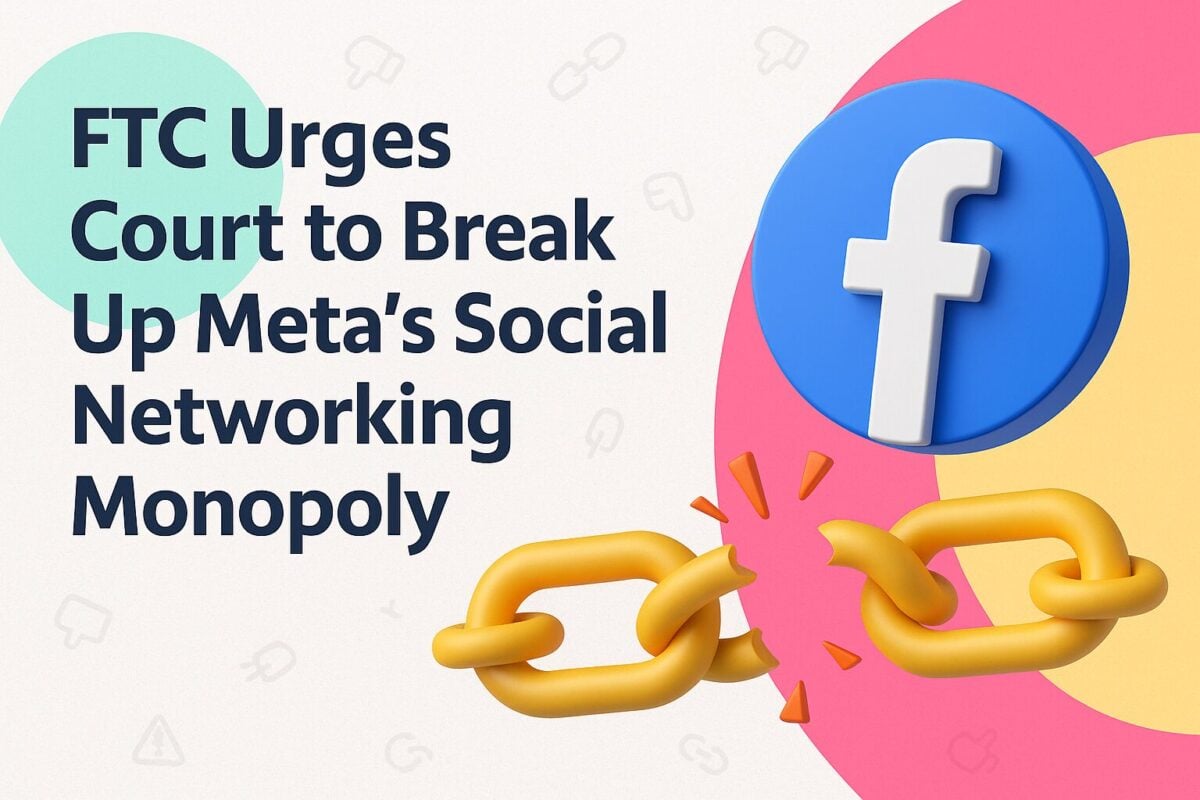Is SEO dying? Ask some, and they'll tell you SEO is dead. But don't believe 'em. Not only is SEO alive and well—it's thriving. And it's partly because of the pandemic. More people than ever are using the internet to learn, work, and play.
According to Forbes, internet usage has increased by 70% since COVID. And Pew Research states 90% of Americans say the web is essential or important to them.
So if you're second-guessing playing the long game with search engine optimization...stop. Today, it's critical to have an SEO copywriting strategy for your business. In fact, it may be even more important than your social media strategy. One report shows SEO drives 1000% more traffic than organic social media.
Of course, tying the two together can drive amazing results. But to do that, you need to understand how to create SEO content that drives organic traffic and sales. So that's what we'll discuss today.
Stick around to learn how to use SEO copywriting to drive business growth in 2024 (and beyond).
What is SEO copywriting?
SEO copywriting is the art of using keywords and persuasive writing to drive higher traffic and conversion rates for a website. The keywords tell search engines what the page is about to properly rank it. And if you're lucky (and skilled), you may reach page #1.
Then with your persuasive writing skills, you can capture your audience's attention and guide them to take a specific call to action. For example, "download my free eBook" (in exchange for your name and email address).
There are several ways you can use SEO copywriting to benefit your business. Here are a few examples:
- Landing page of a product or service
- Blog post discussing an irking problem and how your product/service can help
- Video demonstrating your product or service (with an optimized meta description, script, and transcript)
- Product descriptions detailing the benefits and features of a product or service
But to see any results from your SEO copywriting efforts, you need to understand how to master it. We'll guide you through the "how" below.
What are the benefits of SEO content writing?
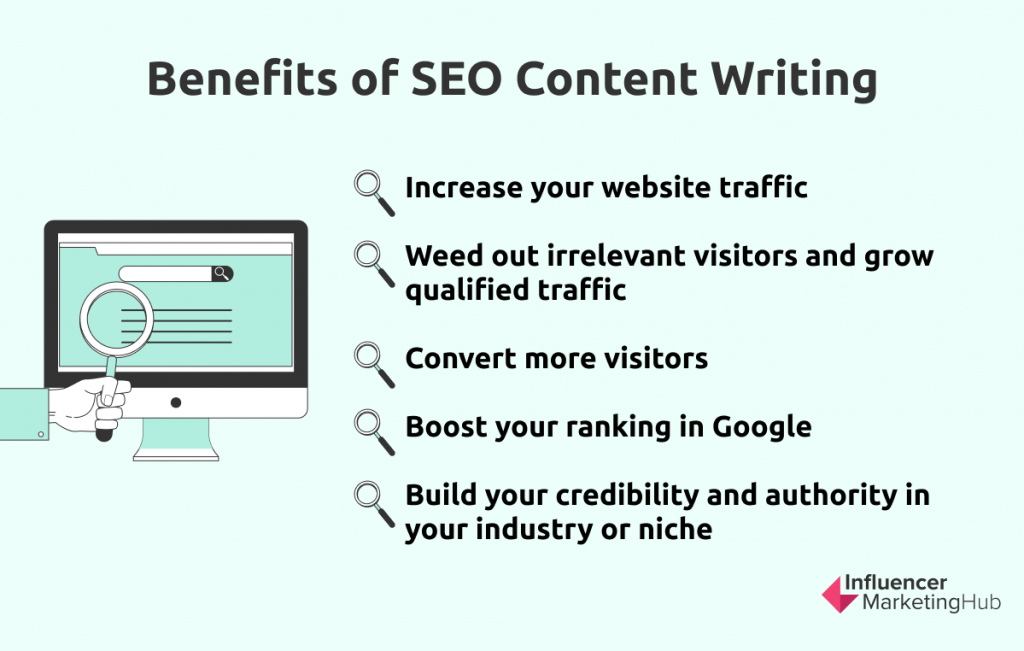
SEO copywriting is critical for businesses because many of today's consumers shop on the web. So if your website and content don't show in their searches, you'll lose them to competitors.
With effective SEO copywriting, you can:
- Increase your website traffic (with high-volume search terms)
- Weed out irrelevant visitors and grow qualified traffic (with intent-focused content)
- Convert more visitors (with persuasive copy and calls to action or CTAs)
- Boost your ranking in Google (with improved metrics like more time spent on page and low bounce rates)
- Build your credibility and authority in your industry or niche (and gain trust from prospects)
Without SEO copywriting, you'll struggle to rank in Google and convert visitors. Being good at one and not the other isn't enough. For instance, having excellent SEO skills can drive traffic. But you'll fail to keep them on your site, let alone convert them.
And if your copywriting is on point, but your SEO is non-existent, then you won't rank, and your page views will suffer. Since there's no traffic, you can forget about boosting your conversions and sales.
So if you're asking whether a copywriter needs to know SEO, the answer's a resounding yes.
Next, let's dive into what it takes to create high-performing SEO content.
Phase one: Getting your SEO in order
There are three phases of SEO copywriting. The first: preparing your SEO strategy for the content. The second: zoning in on the actual writing. And the last phase: focusing on optimization.
Here are the three steps to building an SEO strategy for each piece of content you create.
Understand your target audience
You don't start your SEO research in a keyword tool. It begins with your target customers. Who are they? What do they need? What questions and concerns do they have? How can you help them?
If you don't know, then it's time to talk to them directly. Sit in on sales and support calls, read through call transcripts, and conduct customer surveys. Don't just read through reviews and testimonials. Find out their pain points and reasons for not choosing your brand over another.
Jot down topic ideas
Use information from your customer research to brainstorm topic ideas. You can turn questions into blog posts. Plus, you can use tools like Frase and BuzzSumo to find additional ideas revolving around the topics you came up with.
See if you can develop clusters to cover topics adequately. Frase is excellent for this—it shows various LSI keywords/topics so you can ensure your content is in-depth. This will come in handy when creating your outline.
Perform keyword research
Now, it's time to dig into keyword research. Use a tool like Surfer SEO, Ahrefs, Frase, or Semrush to find high-volume search terms with low competition.
But don't just look at the numbers—look at search intent as well. For instance, you can categorize search intent as informational (looking for answers), transactional (looking to buy), or navigational (looking for a specific brand, website, or page).
Then you can take it further by classifying the keywords based on the customer journey—top, middle, or bottom of the funnel. The closer to the bottom, the higher the intent to purchase. It's ideal to start from the bottom to get higher conversions at the get-go.
Long-tail keywords are optimal since they're easier to rank for. These are more targeted, which will drive higher targeted organic traffic to your post.
Once you have your list of keywords, it's time to write.
Phase two: Writing winning copy
Like keyword research, your path to creating high-converting copy doesn't begin with writing. You have to take several steps before putting the proverbial pen to paper.
Let's review:
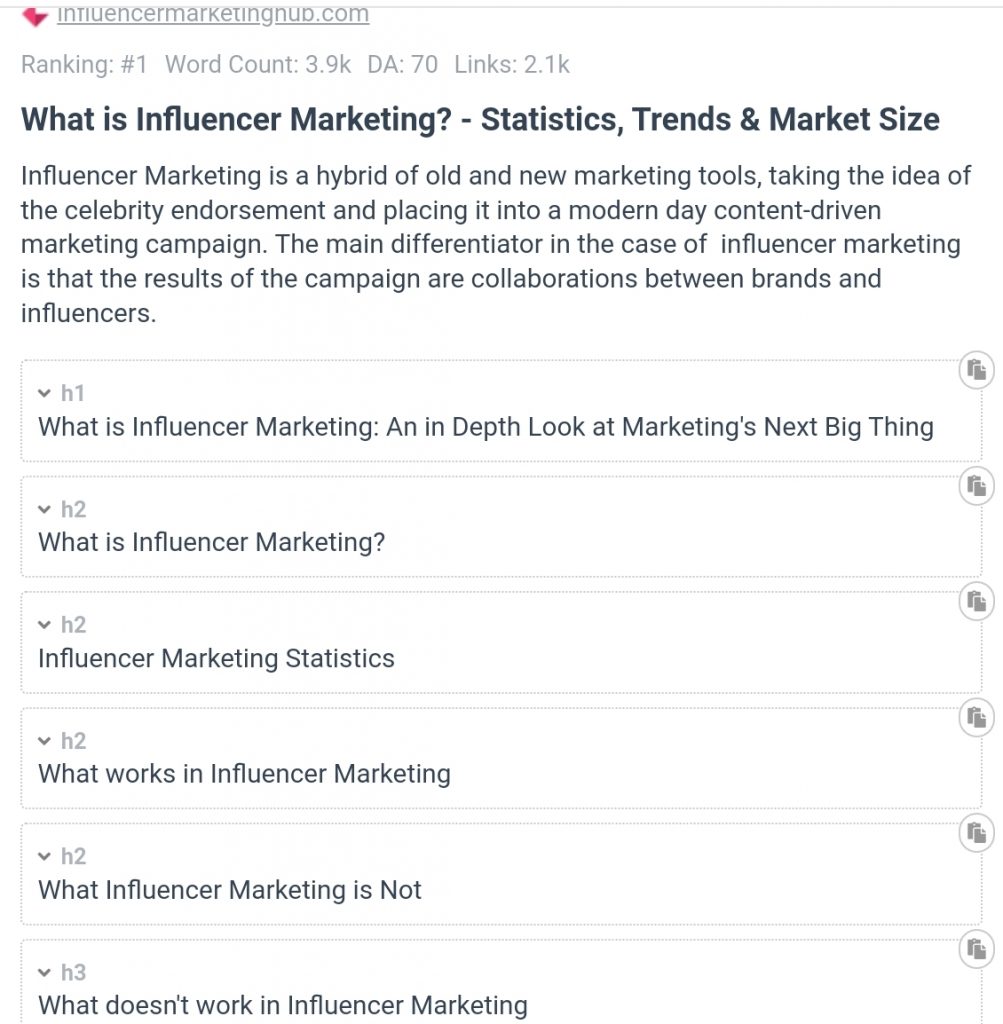
Analyze the first page of Google (aka your competitors)
Type in the target keyword you're writing for. What do you find on the first page? This is vital to know to ensure you're writing content Google wants, and surpasses what's already there.
So analyze their sub-headings to see what they cover. Tools like Frase speed this up by pulling the top 20 pages from the search engine results page (SERP), then laying out their h2s in an easy-to-see format.
Otherwise, click through the top 10 results and look at their structure. See what sub-topics to cover and what they're missing. Cover the gaps in the content by gathering the h2s from the top 20 (or even 30) pages for the search term.
Also, look at:
- The content types (are the pages blog posts, landing pages, sales pages, PDFs, videos?)
- The content formats (are they how-tos, listicles, opinion pieces, news articles, reviews, etc. And do they include video clips, lots of images, etc.?)
- The content angle (are they written for beginners or experts, or is the position positive, negative, or neutral?)
Use this to guide your approach to creating original content.
View the "people also ask" section
Scroll below the ads in Google and you'll see a "people also ask" section. Here, you'll find hidden gems to add to your content. Include these questions and answer them thoroughly, so Google (and your readers) find your blog post comprehensive and share-worthy.

Doing so can reward you with backlinks (aka link juice), which is critical for building your way to page #1.
According to Ahrefs, more backlinks equals higher traffic for pages on Google.
Identify rich snippets
Certain search terms bring up maps, signifying a local search. Others may showcase recipes, images, product listings, or answer boxes. See how you can get your content into rich snippets that appear for your search term.
For instance, if there's an answer box, structure your h2s as questions and answer them within the first sentence. You can also structure your answers as lists with multiple steps or solutions.
Outline your article
Now, it's time to create your content outline. Using your research, create a rough outline with h2s covering the sub-topics your competitors are discussing. And the questions in the "people also ask" section. Your outline will evolve as you conduct additional research.
Other sources you can use to expand your research include:
- Youtube (find videos you can embed or pull info from)
- Social media (find posts you can embed as images or quotes)
- Influencers (reach out to experts in the industry to obtain quotes)
- H.A.R.O. (put out a request for quotes and watch them pour into your inbox)
- Listen Notes (search through podcasts to find angles, tips, and quotes for your piece)
- Research reports (find data from reputable sources to back your points—no older than two years)
- Frase or other SEO tool (find LSI terms and questions from forums to discuss and research further)
Create your ugly first draft
Some argue against writing ugly drafts, but brain dumping gets you past writer's block and blank pages quickly. Take all the information you gathered and get them on the page. Then go through it and reorganize it so the flow is fluid.
Right now, you're not writing for search engines; you're writing for people. You'll worry about the optimization portion later. So focus on answering questions thoroughly and cohesively connecting the dots.
Make a pretty final draft
Next, improve your rough draft by fixing grammatical errors and adding elements to make the post digestible. This includes:
- Adding images (grab charts from research reports, embed codes from social influencers, or create your own graphics using Canva)
- Adding quotes (make sure the quotes you gathered add to the storytelling vs. sticking out like a sore thumb. Use the block quote feature to help it stand apart in a good way)
- Breaking up paragraphs (two to three sentences per paragraph keeps boring blocks of text at bay)
- Creating h2s and h3s that explain each section (for skimmability)
- Writing informative paragraphs written with clarity (no fluff or unnecessary jargon)
- Using bullet points and numbered lists where appropriate
- Reading it out loud (so it sounds as captivating as it looks on screen)
Phase three: Optimizing your final draft
After completing your final draft, it's time to optimize it. Make sure your primary keyword is in the intro, at least one h2, and somewhere in the body. Don't overdo it, so it doesn't appear spammy and difficult to read.
Some experts say keyword density should be between 2% and 3%. Tools like Surfer SEO show over-optimization to cut down on keyword usage.
Find variations of the primary keyword to enhance readability, depth, and SEO. Use a tool like Hemingway, Grammarly, or ProWritingAid to check the reading level. It's ideal to keep it at 8th grade or under and free of jargon (unless your target audience is experts).
These tools also catch content issues you miss, like passive language, run-on sentences, and redundancies. They even make your content easier to read by suggesting simpler word alternatives. Afterward, use Frase, Ahrefs, or Semrush to add LSI keywords you missed.
Be sure to link to sites you pulled data, research, quotes, or images from. And interlink with other pages and blog posts on your website. This drives traffic to other relevant content, boosting time spent on your site (and your search engine ranking). This makes creating content clusters genius—they're all relevant and interlinkable.
But if you're not working with clusters, then here's a neat trick. Type this into Google:
Site: yoursite.com "your topic/keyword"
Then Google will pull up all the pages on your website relating to this search term, so you can link to them. Here's what comes up for IMH for the keyword "influencer marketing:
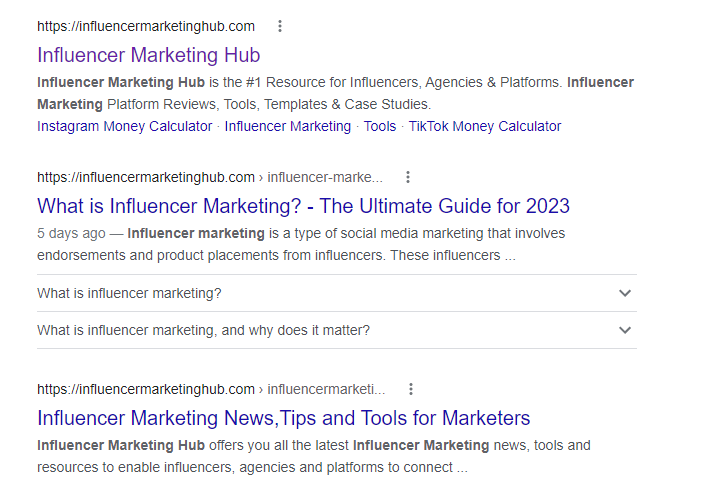
Once you're done optimizing, re-read it aloud to ensure it still flows nicely.
A real-world example of awesome SEO copywriting
Wondering what successful SEO copywriting looks like? Then who better to analyze than the blog post of a content marketing agency? For this examination, we'll review a piece from Animalz on the topic: "Experiment, Systematize, Differentiate: The Content Strategy Maturity Model."
It ranks on the first page for the term "content maturity model." Yet, the content doesn't have this exact keyword phrase anywhere. This proves how smart Google's getting and why LSI keywords reign supreme.
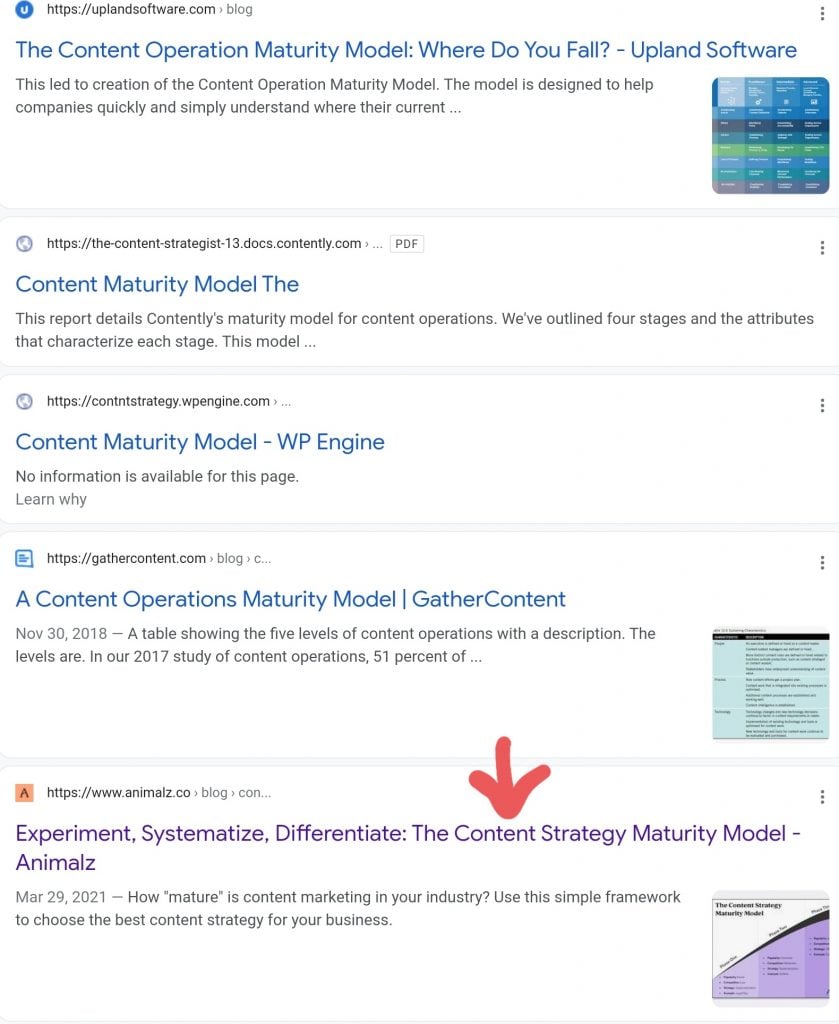
If a term appears in your content (whether in exact order or separated by other words), Google will still rank you for it.
Now, when you look at the article, you'll see a consistent format:
- H2
- Intro paragraph
- Bullet list with explanation/definitions
- Paragraph with follow-up information
- Image to demonstrate topic
- Another paragraph with tips
- Bullet list with examples

Source: animalz.co
You'll also find plenty of links to internal blog posts relating to the topic. Plus, external links pointing to sources of information.
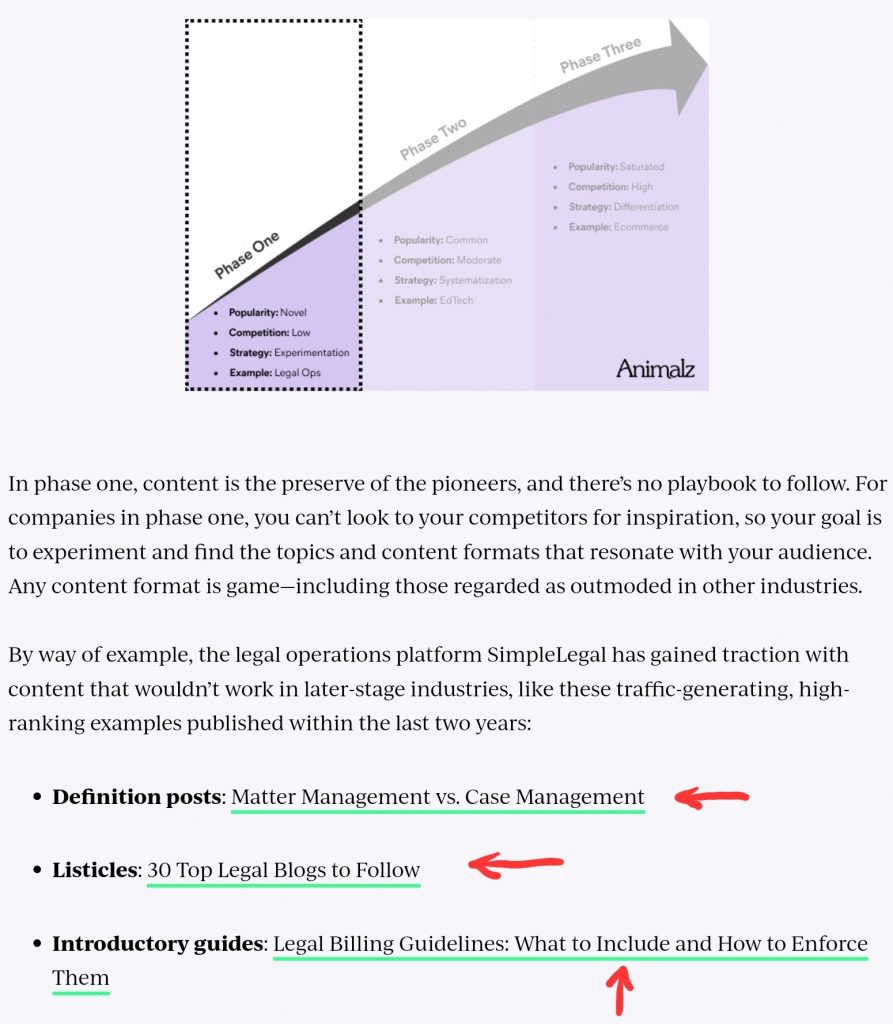
Source: animalz.co
There's no keyword stuffing. The primary keyword appears to be "content strategy maturity model," which appears in the title and once in the intro.
A secondary keyword "maturity model" appears three times—in the title, intro, and body. Then another LSI keyword "content strategy" appears four times—in the title, intro, body, and a h2.
This alone tells Google what the topic is about and proves the writer is an expert, since he's using a variety of related terms.
The content is informative, easy to read, and actionable. It answers the questions a person may have about the content maturity model. Plus, it provides examples, so I have a deeper understanding.
Animalz is a digital marketing agency, but they don't close with a CTA. This is a top-of-the-funnel piece, targeting folks looking for information. So it wouldn't make sense to ask them to convert now.
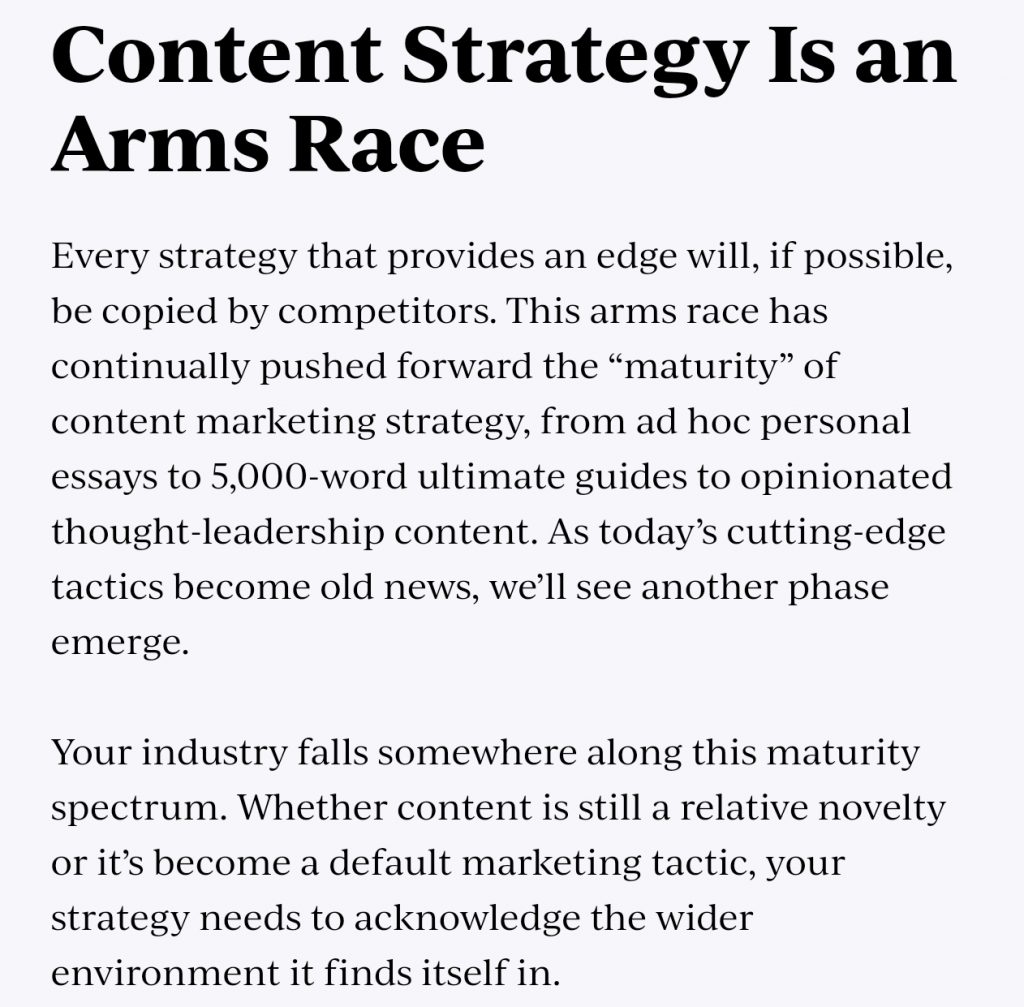
Source: animalz.co
All the helpful internal links can direct visitors to other pages, leading them through the funnel. Eventually, they may land on a page further down the pipeline that contains a CTA.
But for this blog post, it's about thought leadership. In the marketing industry, thought leadership content builds trust and can convince prospects to reach out on their own.
So take this into consideration when deciding the approach for your conclusions. Speaking of which...
Start writing SEO copy that converts
You don't want to just drive traffic to your website—you want to convert traffic into leads. And to do that, you need an SEO copywriting strategy that revolves around building high-quality content that meets your primary goals.
So whether you need to grow an email list or sales, compelling content can get you there. Just remember, you're writing content for people first, robots second. With this guide to SEO copywriting, you have the steps needed to make that happen.
Focus on learning your target customers, finding relevant keywords, writing in-depth content, and link building. This will improve your ranking, build your reputation, and improve conversions. Win-win for everyone.
Frequently Asked Questions
What is an SEO copywriting?
SEO copywriting is the process of matching standard SEO best practices that drive traffic – like keyword research – with enticing words that urge users to take specific action, like buying services or subscribing.
How do I start SEO copywriting?
Here’s how to start SEO copywriting successfully:
- Identify the right keywords
- Understand questions people ask
- Map search intent
- Check competitors’ articles for your target keywords
- Optimize your header, meta title and meta description
- Create organized, easy-to-read content
- Include visuals
Is SEO the same as copywriting?
Copywriting is different from SEO content. The biggest difference between copywriting and SEO content is the goal. SEO content is created to educate users and increase rankings. The big purpose of copywriting, however, is to convert traffic into leads and sales.
Should I learn SEO for copywriting?
To be a good SEO copywriter, you need to ensure that you have these 3 SEO skills intact: writing, marketing, and technical knowledge. You need to learn to write for both search intent and search engines.

